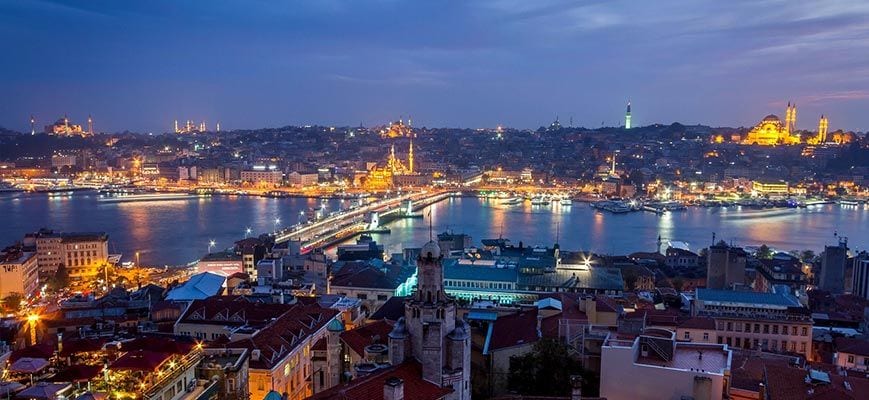Information
Istanbul Information
The city of Istanbul, measuring 5,712 square kilometers, is the largest city in Turkey and one of the largest in Europe. Capital of two empires, it is also one of the four cities in the world and undoubtedly the most spectacular that sits on two continents: Europe and Asia, limit imposed by the Bosphorus Strait, the only trade route between the Mediterranean Sea and the Sea Black, through the Sea of Marmara.
Istanbul has an enviable and strategic geographical location, which inserted it into the famous Silk Road and the main railway networks to Europe and the Middle East, as well as having the Bosphorus and the Golden Horn (sea language that penetrates the city and has become an important means of transport, commerce, navigation and tourism). Although it ceased to be the capital of the country (which passed to Ankara with the establishment of the Republic in 1923), Istanbul is the great protagonist of the life and spirit of Turkey.
With a population of more than 12 million people, according to official figures – popularly believed to be much lower than the real population -, Istanbul is one of the largest urban agglomerations in Europe and the world in general. Its population is predominantly Muslim, although there are Christian and Jewish minorities and it functions as the seat of the Ecumenical Patriarchate of the Orthodox Church.
For its surprising contrasts and its intercontinental character, Istanbul is one of the most fascinating cities on the planet: millenarian and modern, European and Asian, demure and liberal; a city of mysteries and magic, of incredible history and rich culture; city that has inspired countless works of art and one of the main tourist destinations in the world, recommended among the top ten sites to visit in 2013, according to the New York Times.
Istanbul is in turn the administrative capital of the province of Istanbul. In 1985 its historic center was selected by UNESCO as World Heritage of Humanity. It is considered a “Global City” and in 2010 it was declared the European Capital of Culture. It is one of the strongest candidates for the venue of the 2020 Olympic Games.
Settlement primes and foundation of Bızancıo
The first human footprints in the area that today occupies Istanbul were found in its Asian part and date back to the Neolithic Period. In 680 BC, also in the region of Anatolia, the city of Chalcedon was founded by the inhabitants of Megara who fled the Doric persecution. But it would not be until 20 years later that the real history of Istanbul would begin, when the megarein settlers created Byzantium, on the other side of the Bosphorus.
The Golden Horn was the area of the first Thracian Acropolis, which subsequently lived a period of Persian domination until it was reconquered by the Greeks and was part of the League and the Second Athenian Empire, until gaining its independence and then being disputed by the Usurper Pescenio Niger and Emperor Septimius Severus, who after winning and devastating it signed a protection and reconstruction agreement and ended up annexing it to the Roman Empire.
Constantinopla and the Bizanantine Empire
With the coming to power of Constantine, the ancient Byzantium reached great splendor, becoming a new Christian city known in its infancy as Nea Rome and later as Constantinople (in tribute to the emperor), center of Greek culture and Christianity. Thus, on May 11, 330, Constantinople was proclaimed the capital of the Byzantine Empire or Roman Empire of the East.
Walls and numerous churches began to be built then, among them Haghia Sophia (Hagia Sophia), which for a thousand years was the largest cathedral in the world. The Hippodrome, which became the center of civic and social life in the city, was also renewed and expanded. Towards the end of the Byzantine era, Constantinople was the largest and most prosperous city in Europe and sometimes became the largest in the world.
Years later, after the first conflicts between Catholic and Orthodox Christendom, Constantinople became the seat of the Orthodox Church, until today. In 1096 he receives the First Crusade, without affecting it; but after the fourth, the city is invaded and plundered. Soon it would fall back into the hands of the Greeks, in what became known as the Latin Empire, created by the Catholic Crusaders to replace the Byzantine and a quite ephemeral existence. Although the Byzantine Empire soon recovered, the city in general, its defenses, its churches, its sites, were considerably weakened and its population diminished.
The Ottoman Empire
Taking advantage of a weakening panorama, Sultan Mehmed II, the Conqueror, after an eight-week siege, finally took Constantinople on May 29, 1453 and declared it the new capital of the Ottoman Empire. Accordingly, from Santa Sofia, an imam was summoned to proclaim the Islamic creed and the once Byzantine cathedral became an imperial mosque.
From then on, beautiful mosques, palaces and madrazadas began to be built in Constantinople, among other Ottoman and Islamic constructions, although towards the nineteenth century an architectural trend towards European styles such as Baroque and Rococo was noted.
In 1919, after the end of the First World War, in which the Ottoman Empire was defeated with the Entente; the winning allies occupied the city according to areas of influence and interest, which triggered a War of Independence that would ruin the establishment of the Republic of Turkey in 1923. Among the first measures taken, the sultanate and the caliphate were abolished and Ankara became the capital of the new country.
But despite this, Istanbul is today the most important Turkish city and its source of cultural, industrial and commercial splendor. In recent years, and driven among many other factors by the growing economic development of Turkey and its new emerging power role in the region, as well as by its pretensions to enter the European Union; Istanbul has become a modern Megalopolis.


